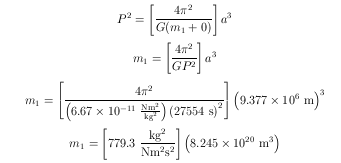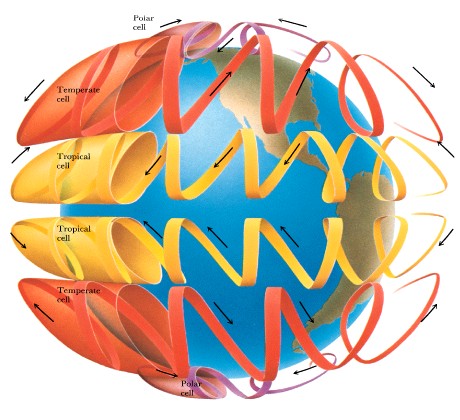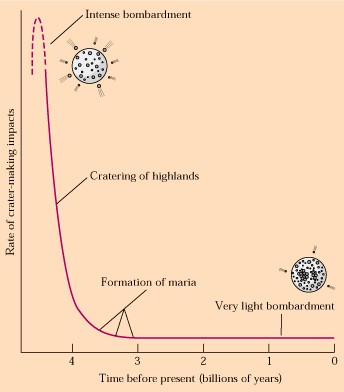Chapter 7 Question
3: Pluto
Pluto does not fit
the usual classification of terrestrial or Jovian because its average density
is much lower than the terrestrials (more like the Jovians) but it does
not have a huge large atmosphere like the Jovians. Based on its density
(1100 kg/m3) Pluto is probably composed of a mixture of rock
(density ~3000 kg/m3) and ice (density ~1000 kg/m3).
Chapter 7 Question
4: Largest satellites (moons).
The 7 largest moons
are almost as large as the terrestrial planets. Also, they have average
densities that higher than all of the Jovian planets. From the average
density, spectroscopic studies, and spacecraft visits, we know that many
of these moons have rocky surfaces, like the terrestrial planets
The 7 largest moons
are the 4 Galilean moons of Jupiter:
Io
Europa
Ganymede
Callisto
Our moon
Titan (Saturn)
Triton (Neptune)
Chapter 7 Question
7: Average density
Average density
is defined as total mass divided by total volume (note typo in box 7-1).
If the average density of a planet is high (>3000 kg/m3), the
planet is terrestrial. If it is low (<2000 kg/m3),
the planet is probably Jovian. The average density can also gives
an indication of the internal structure of a planet. For instance,
most rock on the surface of the Earth is a density of ~3000 kg/m3,
but the Earth's average density is 5515 kg/m3. Therefore,
there is something much denser inside the earth (its iron core).
Chapter 7 Question
21: Spectral lines from a moon.
Looking at one spectrum,
it is difficult to tell which lines come from which source. However,
if several spectra are recorded as the moon orbit its planet, the Doppler
effect will shift the moon's lines back and forth (to the red and the blue)
while the Earth's lines will stay in the same place. The Sun's lines
will be shifted even more than the moon's lines because of the combined
motion of the Sun and the moon and the moon and the Earth.
Chapter 7 Question
22: Mass and average density of Mars
Using the orbital
information of the Martian moon Phobos, we can calculate the mass
and average density of Mars. Since we have a distance and a period
and want a mass, we can use Newton's form of Kepler's 3rd law.


Like we did in the last homework, we can assume the satellite has a negligible mass compared to Mars, or m2 = 0. Since 0 is a nice easy number to work with, lets plug that is first, solve the equation for m1 while it is still just variables and then plug in.

Chapter 8 Question
4: Center of the Earth
Scientists have
studied the inner structure of the Earth using seismic waves. Waves
that originate on one side of the globe at the site of an earthquake can
be detected over most of the Earth. From the intensity of the waves
in different places, scientists have deduced the density structure inside
the Earth.
Chapter 8 Question
7: Plate tectonics
The Earth's crust
is broken up into sections called plates. These plates are floating
on a layer of semi-liquid (plastic) rock called the asthenosphere.
Convection in the asthenosphere (the lava lamp effect) disturbs the plates
and causes them to move relative to each other. Mountain ranges,
such as the Andes, Rockies and the Himalayas have been pushed up along
the boundaries of two colliding plates. The Mid-Atlantic ridge is
a range of mountains in the middle of the Atlantic Ocean that has formed
as two plates separate and new crust is added volcanically from below.
Chapter 8 Question
11: Structure of Earth's atmosphere.
The Earth's atmosphere
is divided into four layers by differences in the behavior of the temperature
in these regions (see figure). The Earth's atmosphere is mostly nitrogen,
but life, specifically plant life, has produced large amounts of oxygen.
Now the Earth's atmosphere is almost 1/4 oxygen. The lower
region of the atmosphere (the troposphere), is not efficient at absorbing
energy directly from the Sun (unlike the Ozone layer in the stratosphere).
Instead, sunlight falls on the ground which then heats the atmosphere from
the bottom. The hot air rises and moves toward the colder parts of
the Earth's surface. The resulting circulation (called convection)
would tend to move air from the equator to the poles, but the rotation
of the Earth breaks this pattern up (see figure).


Chapter 8 Question
15: Earth's surface relatively crater free
First of all, the
moon and the Earth have been bombarded at the same rate since they started
orbiting each other. Mars and Mercury also have had similar bombardment
rates. The Earth's surface, however, is being continually renewed
by the processes of plate tectonics and volcanism. Wind and rain
also act to wear mountains down even as they are formed. As a result,
impact craters from meteors are erased within a few hundred million years.
The moon and Mercury and Mars do not have any plate tectonics nor (at present)
surface water. As a result, there are fewer processes that can erase
the impact craters.
Chapter 8 Question
18: The ages of Hawaii and Kauai islands.
The Hawaiian islands
are over a hot spot in the Earth's mantle. The hot spot stays in
the same place, but the Pacific plate moves at the rate of 5 cm per year
northwest. Volcanoes that form over the hot spot eventually become
extinct as the plate moves too far from the hot spot. When a new
path for the magma to reach the surface forms, a new volcano is born, to
the southeast of the older volcanos. If two islands are separated
by 300 miles we can calculate their relative ages using the speed of pacific
plate. It is easiest to do this problem if you just write down the
numbers and their units to see how to multiply or divide them to get years
in the final answer. But first lets convert miles to centimeters
so we have consistent length units:
Now we experiment with multiplying and dividing until the units cancel to give us years:
Chapter 9 Question
3: Temperature on the moon
The temperature
swings on the moon are more severe than on the Earth because the moon has
no atmosphere to store heat. Our atmosphere, particularly the
CO2 in our atmosphere acts like a blanket. This is why
the increase in the CO2 content in the atmosphere shown on page
214 of the text is potentially alarming.
Chapter 9 Question
4: Moon rocks are so old...
The moon and the
Earth probably formed at about the same time. The moon, however,
being smaller, cooled faster and long ago ceased to have processes like
volcanism and plate tectonics, which can bring recently molten material
to the surface.
Chapter 9 Question
6: Few craters on the Maria
Shortly after the
planets formed, there were still a lot of planetesimals floating around.
These planetesimals continued to rain down for about a billion years.
Toward the end of this intense period of bombardment, a few relatively
big objects hit the moon. The craters were deep enough to weaken
the crust and allow lava to pour out onto the moon's surface (the moon
bled). These lava beds are the Maria. Since there weren't many
planetesimals left after this point, there haven't been very many impacts
since then. Thus, the Maria have relatively few craters.

Chapter 9 Question
18: How much does an 80 kg person weigh on the moon?
Weight is the effect
of the force of gravity on a mass. That is, in the "F = ma" equation,
mass is m and weight is F. What is a? The problem-solving
tips box above this problem gives the "acceleration due to gravity on the
Earth's surface" as 9.8 m/s2. That is, a = 9.8 m/s2.
So a person on the Earth whose mass is 80 kg weighs;
F = ma = 80 kg x 9.8 m/s2 = 784 N
Table 9-1 gives the surface gravity of the moon compared to Earth as 0.17. So an 80 kg person would weigh
F = ma = 80 kg x 9.8 m/s2 x 0.17 = 133 N
Another way to approach this problem is to use Newton's universal law of gravitation:

F = (9.795 m/s2)(m2)
In other words, we just derived the acceleration of gravity on the Earth's surface. The same thing works for the moon. Try it!